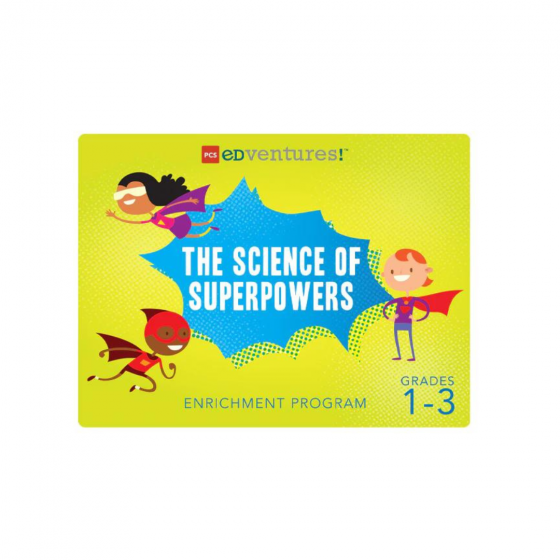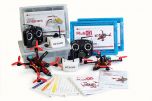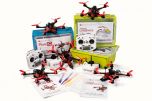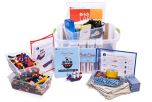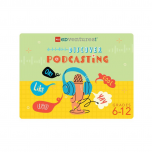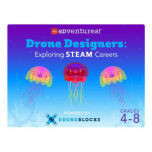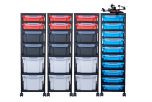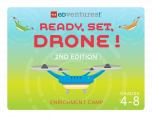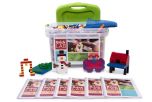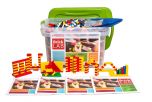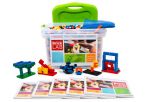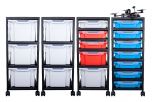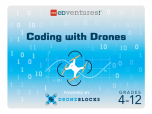The Science of Superpowers
The world of comic books is full of heroes, villains, challenges and triumphs — and the heroes need help! Ready to see just what it takes to be super? In this educator favorite, learners answer the call for aid by dissecting superhero skill sets to uncover the science behind superpowers.
With 12, one-hour STEM lessons in biology, engineering and technology, learners fly alongside Superman, sling webs with Spider-Man and recognize the real-life heroes in their lives. Dive headfirst into the comic universe where student character development, multi-subject integration, creative thinking and community awareness reign supreme.
Grades: 1-3
Students: Up to 30
Contact Hours: 12+
Get to Know:
Subject Targets:
Physical Science, Life Science, Engineering Design, Math Connections
Recommended Settings:
- Summer Camps
- Classrooms
- Before & After-School Programs
Each Activity Includes:
- Schedule
- Opening & Closing Discussion
- Step-By-Step Activity Instructions
- Topic Background & Vocabulary
- Materials List
Curriculum Topics:
- The Origin Story
- The Man of Steel
- The Amazonian Princess
- The Caped Crusader
- The Web-Slinger
- Super Senses
- The Star-Spangled Avenger
- Forces of Nature
- Superhero Training Camp
- The Prince of Puzzles
- The Ace of Knaves
- Superhero Hall of Fame
What's in the Box:
The Science of Superpowers comes with all the supplies needed for 30 students to complete 12 one-hour activities:
- Instructor Guide: 1
- Printed Student Pages: 15 sets
- Curriculum Digital Download: 1
- BrickLAB BrickPACKs: 4
- Brick Separators: 8
- Mesh Bag (for cleaning bricks): 1
- Storage Tub: 1
- Small Storage Containers: 8
- Ball of Yarn: 2
- Balloons: 100
- Colored Pencils (12 pack): 8
- Dry Erase Markers: 15
- Dry Erase Page Pockets: 15
- Headbands: 3
- Magnets: 16
- Paper Clips: 200
- Pencil Sharpeners: 12
- Ping Pong Balls: 8
- Roll of Painter's Tape: 1
- Scissors: 1
- Sticky Notes (100 pack): 1
- Straws: 30
- Tape Measures: 2
- Toothbrush: 8
- Wheel, Tire and Axle Set: 1
Habits of Mind:
16 thinking habits developed by Art Costa and Bena Kallick to empower students to succeed in a 21st-century learning environment.
- Applying Past Knowledge to New Situations
- Creating, Innovating, and Imagining
- Listening with Understanding and Empathy
- Finding Humor
- Gathering Data through All Senses
- Listening with Understanding and Empathy
- Managing Impulsivity
- Questioning and Posing Problems
- Persisting
- Remaining Open to Continuous Learning
- Responding with Wonderment and Awe
- Striving for Accuracy
- Taking Responsible Risks
- Thinking about Thinking
- Thinking and Communicating with Clarity and Precision
- Thinking Flexibly
- Thinking Interdependently
21st Century Skills:
A set of widely-applicable abilities essential for success in the information age.
- Communication and Collaboration
- Creativity and Innovation
- Critical Thinking and Problem Solving
- Flexibility and Adaptability
- Information, Media, and Technology Literacy
- Initiative and Self-Direction
- Leadership and Responsibility
- Productivity and Accountability
- Social and Cross-Cultural Skills
© 2019 Battelle for Kids. battelleforkids.org. All Rights Reserved. Battelle for Kids was not involved in the production of this product and does not endorse it.
Common Core State Standards for Mathematics:
- CCSS.MATH.CONTENT.K.CC.B.5. Count to tell the number of objects.
- CCSS.MATH.CONTENT.1.NBT.C.4. Use place value understanding and properties of operations to add and subtract.
- CCSS.MATH.CONTENT.1.MD.A.1. & CCSS.MATH. CONTENT.1.MD.A.2 Measure lengths indirectly and by iterating length units.
- CCSS.MATH.CONTENT.2.0A.A.1. Represent and solve problems involving addition and subtraction.
- CCSS.MATH.CONTENT.2.MD.A.1. Measure and estimate lengths in standard units.
© Copyright 2010. National Governors Association Center for Best Practices and Council of Chief State School Officers. All rights reserved.
Next Generation Science Standards:*
- NGSS K-2-ETS1-1 Engineering Design
- NGSS K-2-ETS1-2 Engineering Design
- NGSS K-2-ETS1-3 Engineering Design
- NGSS 1-LS1-1 Structure and Function
- NGSS 2-PS1-3 Observing Properties of Matter
- NGSS 3-PS2-1 Forces and Motion
- NGSS 3-PS2-2 Forces and Motion
- NGSS 3-PS2-3 Types of Interactions
- NGSS 3-PS2-4 Types of Interactions
* Next Generation Science Standards and NGSS is a registered trademark of WestEd. Neither WestEd nor the lead states and partners that developed the Next Generation Science Standards were involved in the production of this product, and do not endorse it.
International Society for Technology in Education:
- ISTE-S.3.d Students build knowledge by actively exploring real-world issues and problems, developing ideas and theories and pursuing answers and solutions.
- ISTE-S.4.a Students know and use a deliberate design process for generating ideas, testing theories, creating innovative artifacts or solving authentic problems.
- ISTE-S.4.c Students develop, test and refine prototypes as part of a cyclical design process.
- ISTE-S.5.a.c Students break problems into component parts, extract key information, and develop descriptive models to understand complex systems or facilitate problem-solving.
- ISTE-S.6.b Students create original works or responsibly repurpose or remix digital resources into new creations.
- ISTE-S.7.c Students contribute constructively to project teams, assuming various roles and responsibilities to work effectively toward a common goal.
ISTE Standards for Students, ©2016, ISTE® (International Society for Technology in Education), iste.org. All rights reserved. ISTE was not involved in the production of this product and does not endorse it.
| Manufacturer | PCS Edventures, Inc. |
|---|



